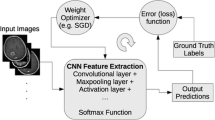Abstract
The hippocampus has become the focus of research in several neurodegenerative disorders. Automatic segmentation of this structure from magnetic resonance (MR) imaging scans of the brain facilitates this work. Segmentation techniques must be evaluated using a dataset of MR images with accurate hippocampal outlines generated manually. Manual segmentation is not a trivial task. Lack of a unique segmentation protocol and poor image quality are only two factors that have confounded the consistency required for comparative study. We have developed a publicly available dataset of T1-weighted (T1W) MR images of epileptic and nonepileptic subjects along with their hippocampal outlines to provide a means of evaluation of segmentation techniques. This dataset contains 50 T1W MR images, 40 epileptic and ten nonepileptic. All images were manually segmented by a widely used protocol. Twenty five images were selected for training and were provided with hippocampal labels. Twenty five other images were provided without labels for testing algorithms. The users are allowed to evaluate their generated labels for the test images using 11 segmentation similarity metrics. Using this dataset, we evaluated two segmentation algorithms, Brain Parser and Classifier Fusion and Labeling (CFL), trained by the training set. For Brain Parser, an average Dice coefficient of 0.64 was obtained with the testing set. For CFL, this value was 0.75. Such findings indicate a need for further improvement of segmentation algorithms in order to enhance reliability.











Similar content being viewed by others
References
Aljabar, P., Heckemann, R., Hammers, A., Hajnal, J. V., & Rueckert, D. (2007). Classifier selection strategies for label fusion using large atlas databases. Medical Image Computing and Computer-Assisted Intervention, 10, 523–531.
Cendes, F., Andermann, F., Gloor, P., Evans, A., Jones-Gotman, M., Watson, C., et al. (1993). MRI volumetric measurement of amygdala and hippocampus in temporal lobe epilepsy. Neurology, 43, 719–725.
Cocosco, C., Kollokian, V., Kwan, R., & Evans, A. (1997). Brainweb: online interface to a 3D MRI simulated brain database. Neuroimage, 5, 425.
Dice, L. R. (1945). Measures of the amount of ecologic association between species. Ecology, 26, 297–302.
Duvernoy, H. M. (2005). The human hippocampus: functional anatomy, vascularization, and serial sections with MRI (3rd ed.). Springer: New York.
Fischl, B., Salat, D. H., Busa, E., Albert, M., Dieterich, M., Haselgrove, C., et al. (2002). Whole brain segmentation: automated labeling of neuroanatomical structures in the human brain. Neuron, 33, 341–355.
Geuze, E., Vermetten, E., & Bremner, J. D. (2005). MR-based in vivo hippocampal volumetrics: 1. Review of methodologies currently employed. Mol Psychiatry, 10, 147–159.
Jack, C. R., Jr., Petersen, R. C., O’Brien, P. C., & Tangalos, E. G. (1992). MR-based hippocampal volumetry in the diagnosis of Alzheimer’s disease. Neurology, 42, 183–188.
Jafari-Khouzani, K., Elisevich, K., Patel, S., Smith, B., & Soltanian-Zadeh, H. (2010). FLAIR signal and texture analysis for lateralizing mesial temporal lobe epilepsy. Neuroimage, 49, 1559–1571.
Jenkinson, M., & Smith, S. (2001). A global optimisation method for robust affine registration of brain images. Medical Image Analysis, 5, 143–156.
Konrad, C., Ukas, T., Nebel, C., Arolt, V., Toga, A. W., & Narr, K. L. (2009). Defining the human hippocampus in cerebral magnetic resonance images—an overview of current segmentation protocols. Neuroimage, 47, 1185–1195.
Lawrie, S. M., & Abukmeil, S. S. (1998). Brain abnormality in schizophrenia. A systematic and quantitative review of volumetric magnetic resonance imaging studies. British Journal of Psychiatry, 172, 110–120.
Munkres, J. R. (2000). Topology (2nd ed.). Upper Saddle River: Prentice Hall.
Rohlfing, T., Brandt, R., Menzel, R., & Maurer, C. R., Jr. (2004). Evaluation of atlas selection strategies for atlas-based image segmentation with application to confocal microscopy images of bee brains. Neuroimage, 21, 1428–1442.
Rueckert, D., Sonoda, L. I., Hayes, C., Hill, D. L., Leach, M. O., & Hawkes, D. J. (1999). Nonrigid registration using free-form deformations: application to breast MR images. IEEE Transactions on Medical Imaging, 18, 712–721.
Shattuck, D. W., Mirza, M., Adisetiyo, V., Hojatkashani, C., Salamon, G., Narr, K. L., et al. (2008). Construction of a 3D probabilistic atlas of human cortical structures. Neuroimage, 39, 1064–1080.
Shattuck, D. W., Prasad, G., Mirza, M., Narr, K. L., & Toga, A. W. (2009). Online resource for validation of brain segmentation methods. Neuroimage, 45, 431–439.
Shen, D. G., & Davatzikos, C. (2002). HAMMER: hierarchical attribute matching mechanism for elastic registration. IEEE Transactions on Medical Imaging, 21, 1421–1439.
Smith, S. M. (2002). Fast robust automated brain extraction. Human Brain Mapping, 17, 143–155.
Studholme, C., Hill, D., & Hawkes, D. (1999). An overlap invariant entropy measure of 3D medical image alignment. Pattern Recognition, 32, 71–86.
Tu, Z., Narr, K. L., Dollar, P., Dinov, I., Thompson, P. M., & Toga, A. W. (2008). Brain anatomical structure segmentation by hybrid discriminative/generative models. IEEE Transactions on Medical Imaging, 27, 495–508.
van Ginneken, B., Heimann, T., & Styner, M. (2007) 3D Segmentation in the clinic: A grand challenge. In T. Heimann, M. Styner, B., & van Ginneken (Eds.), 3D Segmentation in the clinic: A grand challenge (pp. 7–15).
Acknowledgements
This work was supported in part by NIH grant EB002450.
Author information
Authors and Affiliations
Corresponding author
Rights and permissions
About this article
Cite this article
Jafari-Khouzani, K., Elisevich, K.V., Patel, S. et al. Dataset of Magnetic Resonance Images of Nonepileptic Subjects and Temporal Lobe Epilepsy Patients for Validation of Hippocampal Segmentation Techniques. Neuroinform 9, 335–346 (2011). https://doi.org/10.1007/s12021-010-9096-4
Published:
Issue Date:
DOI: https://doi.org/10.1007/s12021-010-9096-4




